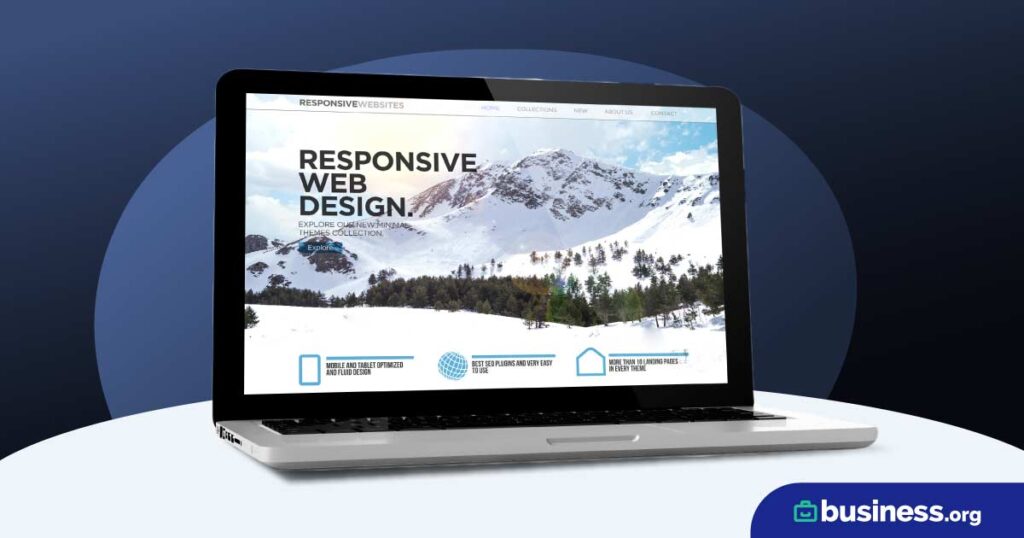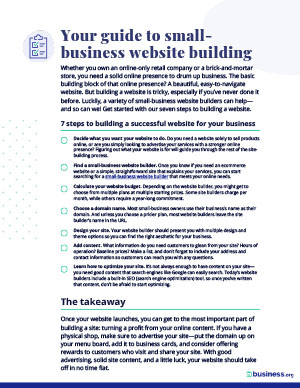We are committed to sharing unbiased reviews. Some of the links on our site are from our partners who compensate us. Read our editorial guidelines and advertising disclosure.
How to Make a Website without a Website Builder
Website builders have become increasingly popular over the last few years. You’ve probably seen ads for companies like Wix, Shopify, and Squarespace that offer a simple platform for getting a website up and running in no time. However, for many small businesses, using a website builder may not be the right fit.
Creating a website without a website builder may take a few more steps (and cost a little more money) but the extra effort can definitely be worth it.
Let’s take a look at why you might want to go this route, and what your options are moving forward.
Why build without a website builder?
A free website builder takes out all the guesswork of putting together a website—it does the coding for you, and usually offers hosting. Sounds great, right? Why even venture out into the unknown of building your own website from scratch?
Depending on the company, website builders come with a number of complications and limitations.
Site builder pros and cons
By creating your own website without a website builder you benefit from being in total control of the outcome.
For many small businesses (especially those with an online store) the choice is clear—creating a website without a website builder offers much more flexibility and customization. But once you’ve decided to proceed on your own, what are your next steps?
By signing up I agree to the Terms of Use and Privacy Policy.
How to make a website without a website builder
Step 1. Register a domain name
The first thing you’ll need to do is select a name for your website. Make it unique to your brand, easy to remember and spell, and not too lengthy. You will have to pay for the ownership of your website’s name, but most domains only cost around $10–$20 per year to maintain. Shop around for a registrar that sounds good to you. BlueHost, GoDaddy, and HostGator are all highly rated.
Step 2. Select a host
Many experts will recommend selecting a web hosting provider separate from your domain registrar, but often the two come hand in hand. Depending on the functionality of your site, hosting fees can run anywhere from $2–$20 per month. Be sure to do your research and watch out for hidden fees, contract lengths, and storage limits.
Step 3. Choose to code or not to code
Once you’ve selected a domain name and web host, it’s time to build your website! Without a website builder, you have two options: code from scratch, or build without coding. Let’s go over the two in detail, and what each entails.
Code your own website
Depending on your knowledge of computer programming, this route can be pretty time-consuming. However, if you do choose to learn the ins and outs of coding to build your own website, you will find these skills useful for the future—especially when you need to make updates to your site.
If you’re passionate about programming, your state may have a local campus that offers coding bootcamps (some as short as 12 weeks), or you could complete a program online.
Either way, in order to code a website you will need to learn HTML and CSS, or a general programming language like Javascript or Python.
From there, you’ll enter code into a frontend/web framework like Bootstrap, React, or Django. Once your code is complete, you can upload the script to your web host.
Build a website without coding
If you’re not familiar with coding, and don’t have the time and resources to learn, building a website through an open source content management system (CMS) might be the more sensible option. Unlike a website builder, an open source CMS allows you to totally customize your website.
Open source software CMS
The most common open source CMS used for building a website is WordPress. In fact, over 40% of all websites are run by WordPress.1 You can either access this software through your web host, or by downloading and installing it on your personal computer. The CMS itself is very robust, so you may want to dedicate some time to a WordPress tutorial—especially if this is your first time using the software.
Another popular CMS is Webflow. Like WordPress, Webflow is an open source software that allows for total customization. Webflow is also known for having better web design customization, rather than relying on pre-made templates.
Templates and themes
Once you’ve become familiar with WordPress, you’ll need to choose a theme. The theme of your website is the overall look and feel, so it’s important to be selective and choose one that resonates with your brand.
You can create and upload your own template to WordPress, or choose from millions of templates available online. If you choose a WordPress theme, you will be able to totally customize the appearance—colors, fonts, photos, logos, etc.
If customizing your web design (even in an easy-to-use template) sounds a little daunting, you might want to hire a freelance web designer to create a custom template for your website.
Hiring a developer
If all of this still sounds overwhelming, but you still don’t want to use a website builder, you always have the option of hiring a professional freelance web developer to build a website for you. Freelancers may charge an hourly rate or fixed rate, and costs can run anywhere from $500 to $3,000. If you have the means, this route may be worth it in the long run since you’ll be saving time, and receiving a high-quality product.
The takeaway
If learning how to make a website without a website builder is important to you, there are dozens of resources at your disposal. Whether you want to learn to code, or use a robust CMS, creating a website without a site builder can be a huge asset for your company.
Want to learn more about building a website for small businesses? Take a look at our Best Website Builders for Small Businesses guide.
Related reading
How to make a website FAQ
Yes. In order to build a website on your own, you need a registered domain name and a web host. From there, you can either use a programming language to code your own website, or a CMS like WordPress or Webflow.
No. If you’re wondering how to make a website without a website builder, there are several options available to you—whether or not you know how to code.
If you want to make a free website, you’ll need to use a free website builder like Wix or Squarespace. A site builder is free to use, and offers free hosting and domain names. However, in order to remain a free website, your domain name will include the company name of the site builder you use, and may include unwanted ads. Free website options are also usually very limited in bandwidth, ecommerce (online store), and storage capabilities.
To make a website from scratch, you can either code the website yourself using HTML and CSS (or a general language like Python or JavaScript), or you can use a CMS with customizable options. Whether you choose this option will depend on you comfortability level with coding.
Disclaimer
At Business.org, our research is meant to offer general product and service recommendations. We don't guarantee that our suggestions will work best for each individual or business, so consider your unique needs when choosing products and services.
Sources
- W3Techs, “Usage statistics and market share of WordPress.” Accessed December 6, 2022.





